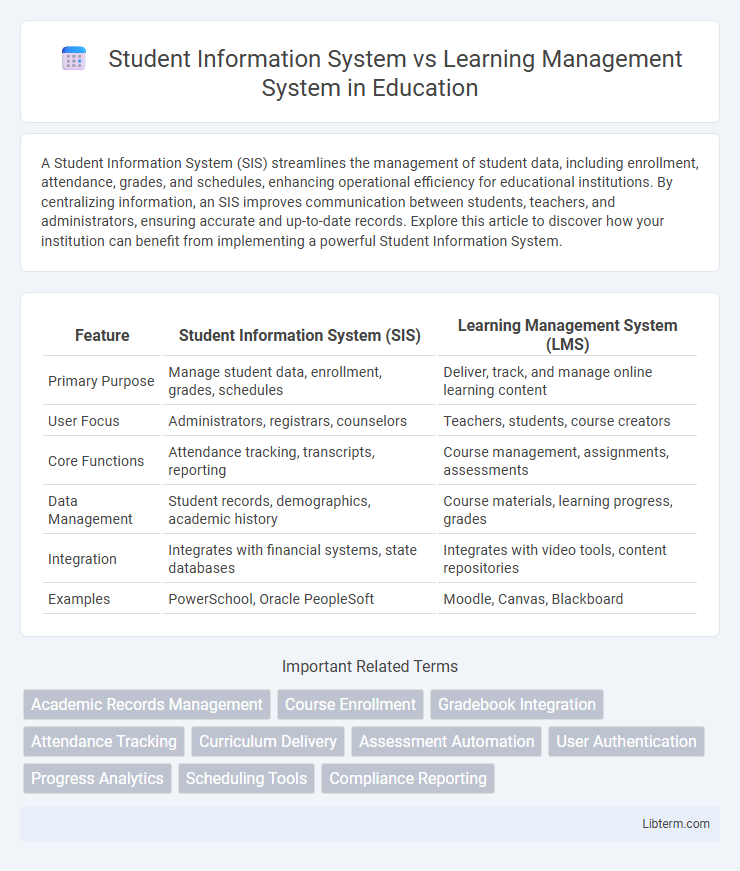A Student Information System (SIS) streamlines the management of student data, including enrollment, attendance, grades, and schedules, enhancing operational efficiency for educational institutions. By centralizing information, an SIS improves communication between students, teachers, and administrators, ensuring accurate and up-to-date records. Explore this article to discover how your institution can benefit from implementing a powerful Student Information System.
Table of Comparison
| Feature | Student Information System (SIS) | Learning Management System (LMS) |
|---|---|---|
| Primary Purpose | Manage student data, enrollment, grades, schedules | Deliver, track, and manage online learning content |
| User Focus | Administrators, registrars, counselors | Teachers, students, course creators |
| Core Functions | Attendance tracking, transcripts, reporting | Course management, assignments, assessments |
| Data Management | Student records, demographics, academic history | Course materials, learning progress, grades |
| Integration | Integrates with financial systems, state databases | Integrates with video tools, content repositories |
| Examples | PowerSchool, Oracle PeopleSoft | Moodle, Canvas, Blackboard |
Introduction to Student Information Systems (SIS) and Learning Management Systems (LMS)
Student Information Systems (SIS) centralize academic administration by managing student enrollment, grades, schedules, and personal data, streamlining institutional operations. Learning Management Systems (LMS) facilitate educational delivery through digital tools for course content distribution, assignments, assessments, and communication between educators and learners. Both SIS and LMS enhance educational efficiency but serve distinct roles--SIS focuses on administrative record-keeping, while LMS targets instructional management and learner engagement.
Core Functions of Student Information Systems
Student Information Systems (SIS) primarily manage enrollment, grades, attendance, and student demographic data, enabling efficient administration of academic records and compliance with educational regulations. Unlike Learning Management Systems (LMS), which focus on content delivery, course management, and learner engagement, SIS provides a centralized database for tracking student history and generating reports crucial for institutional decision-making. Key features of SIS include schedule management, transcript processing, and communication tools that streamline interactions between students, faculty, and administration.
Key Features of Learning Management Systems
Learning Management Systems (LMS) offer comprehensive course management, enabling educators to create, distribute, and track educational content efficiently through features like assignment submission, grading, and automated assessments. LMS platforms integrate communication tools such as discussion forums, messaging, and real-time video conferencing to facilitate interaction between students and instructors. Analytics and reporting capabilities provide insights into learner progress and engagement, supporting data-driven decisions to enhance educational outcomes.
SIS vs LMS: Purpose and Scope Comparison
Student Information Systems (SIS) primarily focus on administrative functions such as enrollment, grades, attendance, and student demographics, serving as a centralized database for schools and institutions. Learning Management Systems (LMS) concentrate on the delivery and management of educational content, assignments, assessments, and tracking student progress in courses. While SIS streamlines institutional operations and data management, LMS enhances the learning experience and instructional delivery.
User Roles: Administrators, Teachers, and Students
Administrators in Student Information Systems (SIS) manage enrollment, attendance, and student records, ensuring data accuracy and compliance with educational standards. Teachers in Learning Management Systems (LMS) create course content, assign grades, and facilitate online interactions, fostering student engagement and personalized learning experiences. Students access LMS platforms to complete assignments, track progress, and participate in discussions, while SIS portals provide them with official academic records and schedules.
Integration Capabilities between SIS and LMS
Integration between Student Information Systems (SIS) and Learning Management Systems (LMS) is crucial for seamless data exchange, enabling real-time synchronization of student enrollment, grades, and attendance information. Modern SIS platforms like PowerSchool and Infinite Campus offer robust APIs that facilitate automatic updates within LMS environments such as Canvas or Blackboard, enhancing administrative efficiency and improving the accuracy of academic records. Effective SIS-LMS integration supports personalized learning experiences by aligning course content with student performance data, streamlining communication between educators and students.
Data Management and Security Considerations
Student Information Systems (SIS) centralize comprehensive student data management including enrollment, attendance, grades, and demographic details, ensuring accurate record-keeping with strict access controls and compliance with FERPA and GDPR regulations. Learning Management Systems (LMS) focus on managing course content, assessments, and learner progress, implementing secure user authentication, encrypted data transmission, and role-based permissions to protect sensitive educational materials and personal information. Both systems require robust cybersecurity measures, frequent audits, and data backup protocols to mitigate risks such as data breaches, unauthorized access, and ensure the integrity and confidentiality of student information.
Impact on Academic Processes and Outcomes
Student Information Systems (SIS) streamline academic processes by managing enrollment, grades, and attendance, ensuring accurate data for administrative decisions and regulatory compliance. Learning Management Systems (LMS) enhance educational outcomes by delivering course content, facilitating communication, and supporting assessments, which boosts student engagement and learning effectiveness. Integrating SIS and LMS creates a comprehensive ecosystem that optimizes both administrative efficiency and academic success through seamless data flow and synchronized workflows.
Choosing the Right System for Your Institution
Choosing the right system for your institution depends on evaluating core functionalities: a Student Information System (SIS) excels in managing enrollment, attendance, and grades, while a Learning Management System (LMS) focuses on delivering course content and tracking student progress. Institutions with complex administrative needs benefit from an SIS, whereas those prioritizing online instruction and interactive learning activities should consider an LMS. Integrating both systems can optimize institutional efficiency and enhance the overall student experience.
Future Trends in SIS and LMS Technologies
Future trends in Student Information Systems (SIS) emphasize enhanced data integration, real-time analytics, and AI-driven personalization to improve student outcomes and administrative efficiency. Learning Management Systems (LMS) are evolving with adaptive learning technologies, immersive augmented reality (AR) experiences, and seamless integration with mobile platforms to foster engaging, flexible education environments. Both SIS and LMS technologies are increasingly leveraging cloud-based solutions and advanced cybersecurity measures to support scalable, secure, and accessible educational ecosystems.
Student Information System Infographic

 libterm.com
libterm.com